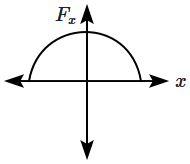| 1. |  |
2. |  |
| 3. |  |
4. |  |
| List-I (x-y graphs) |
List-II (Situations) |
||
| (a) |  |
(i) | Total mechanical energy is conserved |
| (b) |  |
(ii) | Bob of a pendulum is oscillating under negligible air friction |
| (c) |  |
(iii) | Restoring force of a spring |
| (d) |  |
(iv) | Bob of a pendulum is oscillating along with air friction |
Choose the correct answer from the options given below:
| (a) | (b) | (c) | (d) | |
| 1. | (iv) | (ii) | (iii) | (i) |
| 2. | (iv) | (iii) | (ii) | (i) |
| 3. | (i) | (iv) | (iii) | (ii) |
| 4. | (iii) | (ii) | (i) | (iv) |
A spring is stretched by \(5~\text{cm}\) by a force \(10~\text{N}\). The time period of the oscillations when a mass of \(2~\text{kg}\) is suspended by it is:
1. \(3.14~\text{s}\)
2. \(0.628~\text{s}\)
3. \(0.0628~\text{s}\)
4. \(6.28~\text{s}\)
A body of mass \(m\) is attached to the lower end of a spring whose upper end is fixed. The spring has negligible mass. When the mass \(m\) is slightly pulled down and released, it oscillates with a time period of \(3~\text{s}\). When the mass \(m\) is increased by \(1~\text{kg}\), the time period of oscillations becomes \(5~\text{s}\). The value of \(m\) in \(\text{kg}\) is:
1. \(\frac{3}{4}\)
2. \(\frac{4}{3}\)
3. \(\frac{16}{9}\)
4. \(\frac{9}{16}\)
The period of oscillation of a mass M suspended from a spring of negligible mass is T. If along with it, another mass M is also suspended, the period of oscillation will now be:
1. T
2. T/
3. 2T
4. T
The time period of a mass suspended from a spring is T. If the spring is cut into four equal parts and the same mass is suspended from one of the parts, then the new time period will be:
1. T/4
2. T
3. T/2
4. 2T
A spring elongates by a length 'L' when a mass 'M' is suspended to it. Now a tiny mass 'm' is attached to the mass 'M' and then released. The new time period of oscillation will be:
1. \(2 \pi \sqrt{\frac{\left(\right. M + m \left.\right) l}{Mg}}\)
2. \(2 \pi \sqrt{\frac{ml}{Mg}}\)
3. \(2 \pi \sqrt{L / g}\)
4. \(2 \pi \sqrt{\frac{Ml}{\left(\right. m + M \left.\right) g}}\)
The frequency of a spring is \(n\) after suspending mass \(M.\) Now, after mass \(4M\) mass is suspended from the spring, the frequency will be:
| 1. | \(2n\) | 2. | \(n/2\) |
| 3. | \(n\) | 4. | none of the above |


